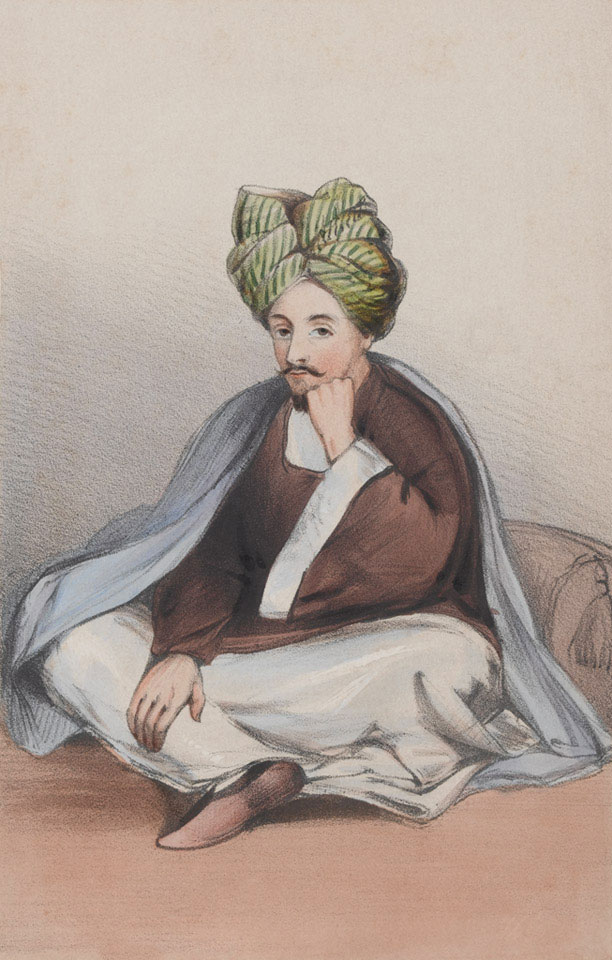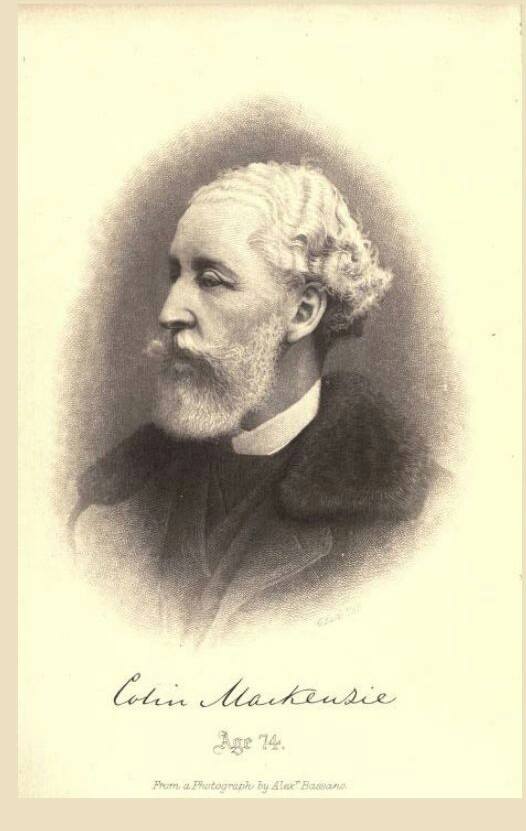Over the years the TRC in Leiden has acquired a large collection of textiles and dress from Afghanistan. Most of it was obtained during my frequent visits to the country between 1978 and 2011. Attention in the West is currently, and understandably, directed towards the Russian invasion of the Ukraine, but the situation in Afghanistan, after some forty years of civil war, is equally horrific. The TRC hopes that its Afghanistan holdings will continue to testify to the rich culture of the country, and to the perseverance of its people in trying to build a peaceful society, free from outside interference.
 Colin Mackenzie in his Afghan dress, after 1843. by James Sant. Courtesy National Army Museum, London, NAM. 1961-10-61-1.
Colin Mackenzie in his Afghan dress, after 1843. by James Sant. Courtesy National Army Museum, London, NAM. 1961-10-61-1.
In 2010 the TRC mounted a special exhibition about Afghan dress, which is now available to other suitable venues (This email address is being protected from spambots. You need JavaScript enabled to view it.). There is also an online exhibition, which can be enjoyed by clicking here. Many of the textiles were used for, and incorporated in Vol. 2 of the World Encyclopedia of Embroidery: Embroidery rom Central Asia, the Iranian Plateau and the Indian Subcontinent, which was published in 2021.
Looking at Afghan dress, and going through Afghan history, I frequently come across weird ‘occurrences’, which the reader may regard as trivial, but which I find fascinating and reflecting directly on the fascinating world of dress.
One of these ‘occurrences’ started with a shower curtain which you can buy for some fifty dollars from Fine Art America. It carries the depiction of a stern looking, obviously European gentleman in Afghan dress. I don’t remember why I came to look at this curtain, but when I did I immediately recognised the gentleman: It is Colin Mackenzie, one of those indomitable British warriors that strode the world in the 19th century, convinced of British superiority and British obligations towards civilizing the rest of the world.
He was one of the captives that survived the disastrous Retreat from Kabul in the winter of 1842 when at the end of the First Anglo-Afghan War the British suffered a disastrous defeat. Some 16,000 soldiers and camp followers were killed, died of their wounds or the cold, or were enslaved. Many of the officers and their family, some 80 in total, were taken hostage, among whom Colin Mackenzie.
After some nine months in captivity Mackenzie and the other hostages were joined by British forces that had returned to Kabul. A few years later, while back in England, he was painted by James Sant (1820-1916). It is a reproduction of this painting which you can admire on the shower curtain. It so happens that since then I have seen the same reproduction on towels, duvet covers, and even on an IPhone case.
Colin Mackenzie had an eventful life. He died in Edinburgh in 1881 (he was buried in the Grange cemetery where his grave can still be seen) and his (auto)biography was published three years later, also in Edinburgh. The title of the book tells it all: Storms and Sunshine of a Soldier’s Life. It informs the reader that Mackenzie, while in captivity in 1842, was wearing Afghan clothes, since his British uniform had been confiscated by his captors. There is even a lithograph, based on an original sketch made by one of the other hostages, showing him in Afghan dress.
 Colin Mackenzie, by Vincent Eyre, drawn while in captivity in Afghanistan, 1842. Called 'the English mullah' by the Afghans because of his religious convictions, he is drawn wearing simple Afghan clothing, with baggy trousers, a tunic, a qabâ-style jacket, a blanket across the shoulders, and some form of turban.In September the hostages were liberated and he joined the British troops that had returned to Kabul. For a while he continued wearing Afghan clothing, When subsequently he joint British forces when they attacked the village of Istalif north of Kabul, he was fired at by his own troops who thought he was Afghan. Is the story true? I doubt it.
Colin Mackenzie, by Vincent Eyre, drawn while in captivity in Afghanistan, 1842. Called 'the English mullah' by the Afghans because of his religious convictions, he is drawn wearing simple Afghan clothing, with baggy trousers, a tunic, a qabâ-style jacket, a blanket across the shoulders, and some form of turban.In September the hostages were liberated and he joined the British troops that had returned to Kabul. For a while he continued wearing Afghan clothing, When subsequently he joint British forces when they attacked the village of Istalif north of Kabul, he was fired at by his own troops who thought he was Afghan. Is the story true? I doubt it.
 Colin Mackenzie age 74.But this is not all: In the painting by James Sant, Colin Mackenzie is wearing luxurious Afghan clothing, such as the rich and mighty were wearing in Afghanistan in the early 19th century. It is certainly not the clothing he wore when he was a captive. How he got hold of it is unknown.
Colin Mackenzie age 74.But this is not all: In the painting by James Sant, Colin Mackenzie is wearing luxurious Afghan clothing, such as the rich and mighty were wearing in Afghanistan in the early 19th century. It is certainly not the clothing he wore when he was a captive. How he got hold of it is unknown.
Most conspicuous is his coat or qabâ, with the characteristic, rectangular chest panel. Such coats are known from various contemporary illustrations from Iran and Afghanistan. He is wearing the coat on top of a red tunic, and under another coat which is made of an ikat material. He has a second coat over the ikat garment. He even wears the typical babouches, the Oriental slippers with an upturned tip, which i could still find in Uruzgan province north of Kandahar some ten years ago. Around his waist he has a kamarband of an expensive material, and on his head he has a turban with decoration along the edges.
The spectacular ‘occurrence’ is that the qabâ worn by Colin Mackenzie in Sant’s painting has survived, and is now housed in the Dumfries Museum, Scotland (DUMF 1978.118). It was identified by Hannah Vickers who published her findings in 2015. The qabâ is made of fulled black wool with couched gold-thread embroidery. The ikat coat and the other garments he is wearing are still missing. Will they ever turn up?
Literature: Vickers, Hannah (2015): ‘Material Cultures: Examining an Afghan coat from Dumfries Museum’, blog, 15 May 2015, Centre for Textile Conservation and Technical Art History, Glasgow University.
Willem Vogelsang, 13 April 2022










